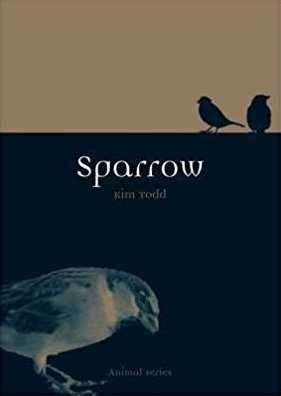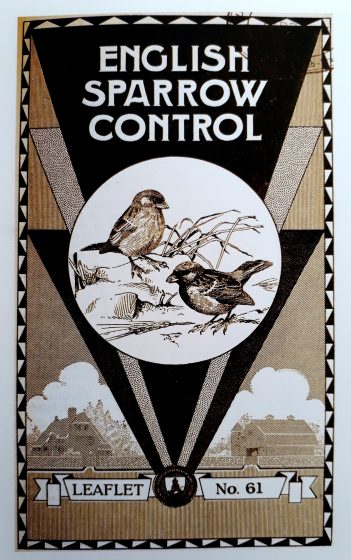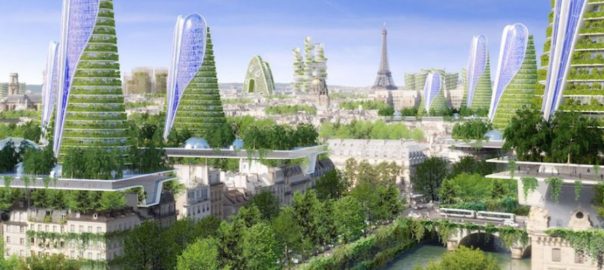A review of: Sparrow by Kim Todd. 2012. 192 pages. ISBN 978-1-86189-875-3. Reaktion Books, London. Buy the book.
 As an urban ecologist, I’ve studied the house sparrow, the “agrarian” (as we call it in some Mexican regions), for over a decade now, and had never been aware of the infinity of human expressions related to sparrows in general. In this book, Todd gathers an impressive cumulus of facts, stories, and references to the generic concept of “sparrow” together with an exquisite palette of artwork by artists from around the globe.
As an urban ecologist, I’ve studied the house sparrow, the “agrarian” (as we call it in some Mexican regions), for over a decade now, and had never been aware of the infinity of human expressions related to sparrows in general. In this book, Todd gathers an impressive cumulus of facts, stories, and references to the generic concept of “sparrow” together with an exquisite palette of artwork by artists from around the globe.
“It’s hard to generalize about sparrows”, Todd argues while transiting spontaneously between their natural history, ecology, distribution, related art, references in stories and books, and shifting species to present different sparrows to the reader, making this book feel like an encyclopedia of sparrows.
“House sparrows are not picky (…) They are risk-takers.” Given their boldness, broad diet, and feeding and breeding strategies and behaviors, they have become one of the most successful invasive birds of the world. Albeit the current perception of the sparrow is, overall positive, it has not been so throughout time. Todd comprehensively reviews the metaphoric use of the sparrow concept in texts and shows that it has been associated with a wide array of perceptions that range from death to love and desire.
But sparrows have not only been on our minds and books, they’ve also been in our crosshairs and on our tables! Haunting images of sparrow hunting together with impressive data on their culinary use color Chapter 2, Sold for Two Farthings. One generally unknown fact related to sparrow massacre is summarized in this book: the massive killing of sparrows (together with rats, mosquitoes, and flies) in Mao’s Great Leap Forward sought to make China competitive industrially with Western nations. “Nature was the enemy of progress, and China would fight back with its most potent weapon—its large population.”

I must confess that, given my interest in the invasion of the house sparrow and its ecological effects in North America, my favorite part of the book is Chapter 4, The Sparrow War. Briefly, this section reviews the reasons behind the idea of introducing birds, including the “English sparrow” in New England. “Slowly, notes of doubt began to creep in. In 1867, Dr Charles Pickering gave a talk at the Boston Society of Natural History, warning of the evils of these introductions.” With a detailed walk-through of the social and environmental process, Todd describes the realization that bringing the sparrow to the New World was not a great idea at all.
By the end of the book, Todd describes the current history of house sparrow studies focused on its ecology and traits that make it an incredibly successful invader, as well as its role in contemporary art, including poetry and photography. “One reason for the sparrow’s success appears to be its flexibility in terms of behavior, particularly when moving to a new place. (…) All of these traits combine to make a very hardy bird. ‘They are survivors’, says researcher Denis Summers-Smith, who is known as the ‘sparrow guru.’
The final chapter emphasizes the environments that sparrows face at present, during the so-called Anthropocene. With the extinction of the dusky seaside sparrow, Todd’s view always contextualizes both the facts and the social perceptions. Finally, the current house sparrow paradox is set on the table, with it being a hyperabundant invasive bird in North America and with declining populations throughout Western European cities. Such a scenario is really intriguing, as no precise answer exists to date to solve the riddle.
To end with a golden snap, Todd wraps this singular piece with a Timeline of the Sparrow, going from “A sparrow ancestor begins to radiate out from the African tropics” 1 million BCE, to “House sparrows join the list of UK’s ‘Birds of Conservation Concern’” in 2002, providing a brilliant temporal synthesis of the book.
Ted R. Anderson’s 2006 Biology of the House Sparrow: From Genes to Populations gave us the first comprehensive radiography of the species from the natural sciences lens. With Todd’s Sparrow, we now have a thorough, yet subtle, expedition through the sparrow concept in an accessible book woven with natural history and cultural knowledge as approachable guiding threads.
Ian MacGregor-Fors
Xalapa
To buy the book, click on the image below. Part of the proceeds return to TNOC.












Hi Melinda! Thank you for your comment, glad to know you liked the review! There are several theories about what is happening with the sparrow in Europe. There’s a really interesting publication by J. Dennis Summers-Smith (“The decline of the House Sparrow: a review”), published in 2003 by British Birds, that reviews the population dynamics of the species in Britain since the 1920s. I know people from BirdLife Netherlands are managing urban infrastructure to help the sparrows nest in buildings. Yet, we have tons here in Mexico and other invaded areas…
A very good review. It makes one interested in the book itself. Sparrows were everywhere in London in the 1980’s. They would eat from your hand. Does anybody know what happened to them? Or how we can get them back?